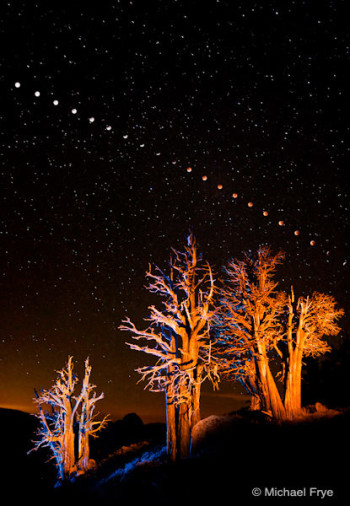Lunar eclipses are spectacular events to see and photograph. I’ve been lucky enough to capture several lunar eclipse sequences over the years, including this one from Yosemite in August 2007.
We’re all going to get another chance at photographing an eclipse soon: a total lunar eclipse will be visible throughout North America early Wednesday morning, October 8th.
In the western half of the U.S. the entire eclipse sequence will be visible, from full moon, to partial eclipse, to total eclipse, and back to full again. In California the moon will be high in the sky to the west-southwest at the beginning of the sequence, then sink near the horizon to the west by the end of the sequence. The moon’s path will actually be somewhat of similar to path in this photograph, except that the eclipse will be higher in the sky and a bit further to the right, and the angle of the moon’s path will be steeper.
On the east coast the moon will set when its fully eclipsed, so it won’t be visible as its coming out of the eclipse. But that means the moon will be near the horizon when its fully eclipsed, where you might be able to photograph it next to an interesting foreground object as the dawn lightens the sky. It should be just north of due west as it sets.
For precise guidance about the moon’s position in relation to the landscape, I recommend consulting PhotoPills or The Photographer’s Ephemeris. Here’s the timing for the eclipse:
Partial Eclipse Begins:
9:14 UT, 5:14 a.m. EDT, 2:14 a.m. PDT
Total Eclipse Begins:
10:25 UT, 6:25 a.m. EDT, 3:25 a.m. PDT
Greatest Eclipse:
10:54 UT, 6:55 a.m. EDT, 3:55 a.m. PDT
Total Eclipse Ends:
11:23 UT, 7:23 a.m. EDT (moon will be below the horizon), 4:23 a.m.PDT
Partial Eclipse Ends:
12:34 UT, 8:34 a.m. EDT (moon will be below the horizon), 5:34 a.m. PDT
So how do you photograph an eclipse? For the eclipse on April 14th this year I wrote a post for the Borrowlenses blog with detailed descriptions of the whole process, including focusing in the dark, exposure, capturing a sequence, and assembling a sequence.
If you can’t photograph this upcoming eclipse, there will be two more total lunar eclipses visible in North America in 2015, on April 4th and September 27th. However, only people in the western half of the U.S. will be able to see a total eclipse on April 4th, and totality will be brief – less than five minutes! East coast viewers will be able to see the entire eclipse sequence on September 27th, while from the west coast the moon will rise fully eclipsed, providing opportunities to juxtapose the moon with foreground objects..
After that, you won’t be able to see a total lunar eclipse in North America until 2018. We’re lucky to have this grouping of four eclipses in two years, so take advantage of it while you can! Who knows if you’ll have clear skies next year, or in 2018?
— Michael Frye
Related Posts: Eclipse; Winging It Through the Eclipse
Did you like this article? Click here to subscribe to this blog and get every new post delivered right to your inbox!
Michael Frye is a professional photographer specializing in landscapes and nature. He is the author or principal photographer of The Photographer’s Guide to Yosemite, Yosemite Meditations, Yosemite Meditations for Women, and Digital Landscape Photography: In the Footsteps of Ansel Adams and the Great Masters. He has also written three eBooks: Light & Land: Landscapes in the Digital Darkroom, Exposure for Outdoor Photography, and Landscapes in Lightroom 5: The Essential Step-by-Step Guide. Michael written numerous magazine articles on the art and technique of photography, and his images have been published in over thirty countries around the world. Michael has lived either in or near Yosemite National Park since 1983, currently residing just outside the park in Mariposa, California.










Michael–Thanks for this very informative post, as well as your earlier one on Borrowlenses Blog. Because I do not have Photoshop, I’m wondering if I can use StarStax to assemble the sequence of photos?
You’re welcome Hadley. I don’t know if StarStax will work, but Photoshop Elements will, and I think On One Perfect Layers as well.
Thank you.
Michael, Was this image of the trees superimposed with the sequence of moon shots. Or did you actually have the moon sequence of shots in the same frame as tree shot?
Thanks,
John
John, if I understand your question correctly, I had “the moon sequence of shots in the same frame as the tree shot.” The camera never moved during the process of capturing the sequence and lighting the trees.
Thank you for your response, I figured that. did you original shoot this vertical or landscape?
It is not cropped.
Hello Michael, I will be in Yosemite next week and there is rain forecast for Tuesday, October 28. Any suggestions as to what the photographic opportunities are in Yosemite on a rainy day?
John, overcast skies are great for photographing fall color, and the colors are even richer when things are wet. But the forecast for Tuesday says “Mostly Sunny.”